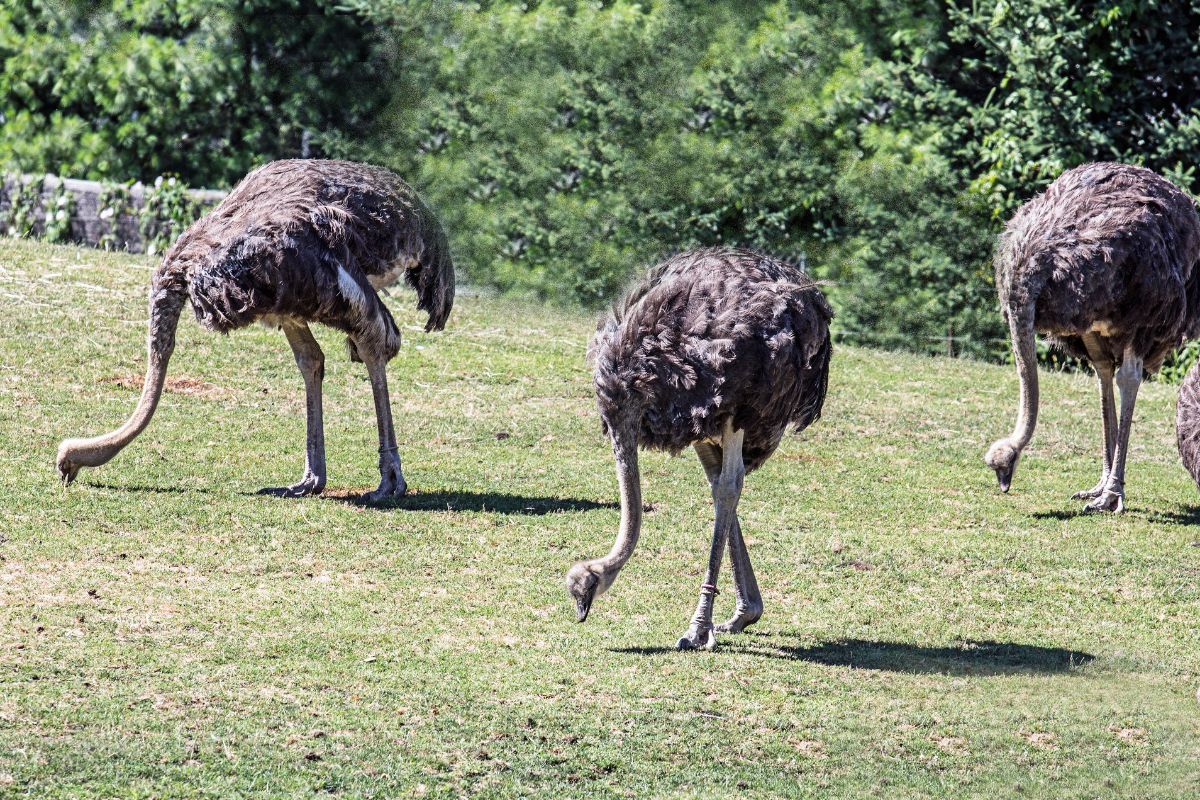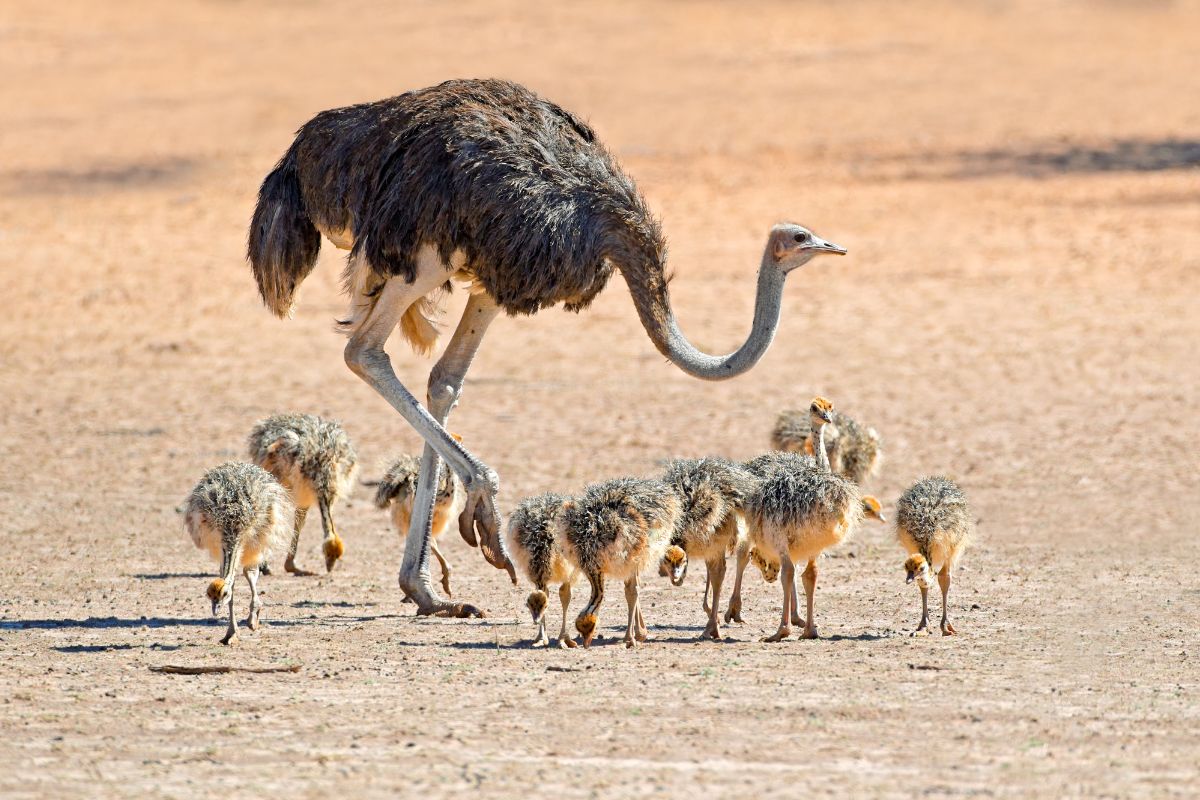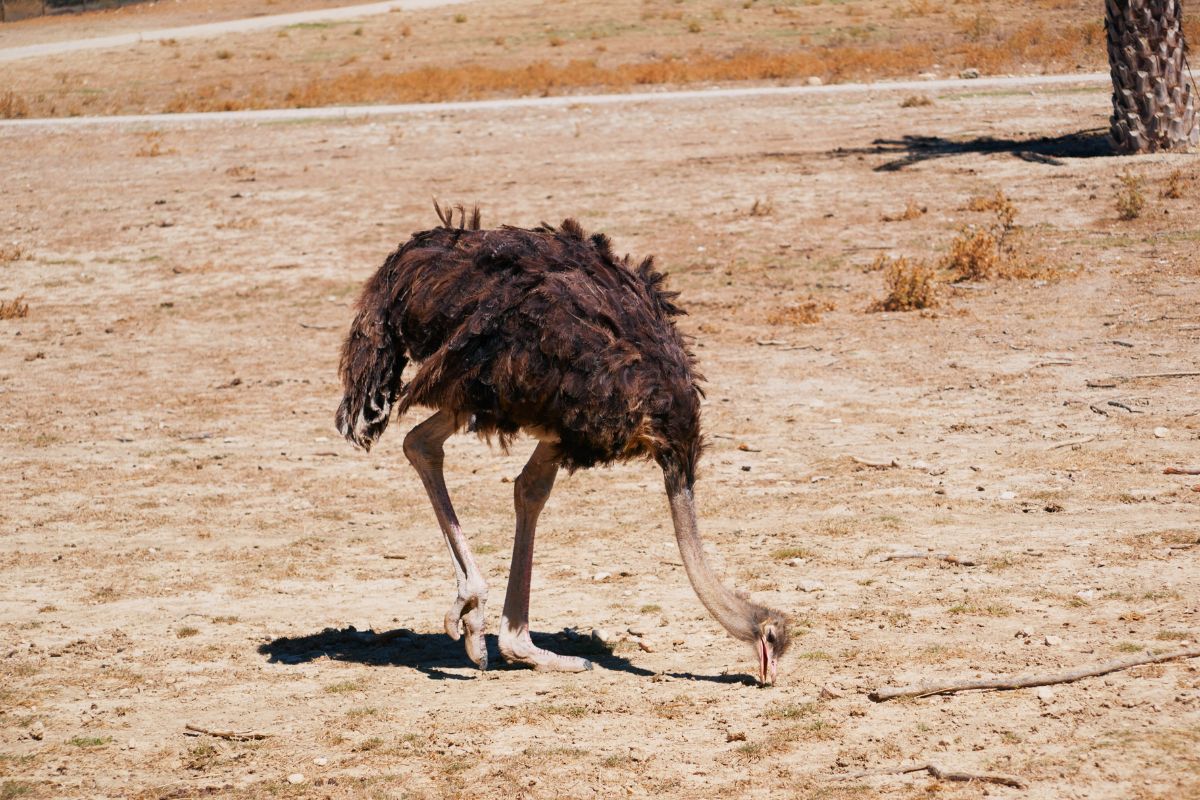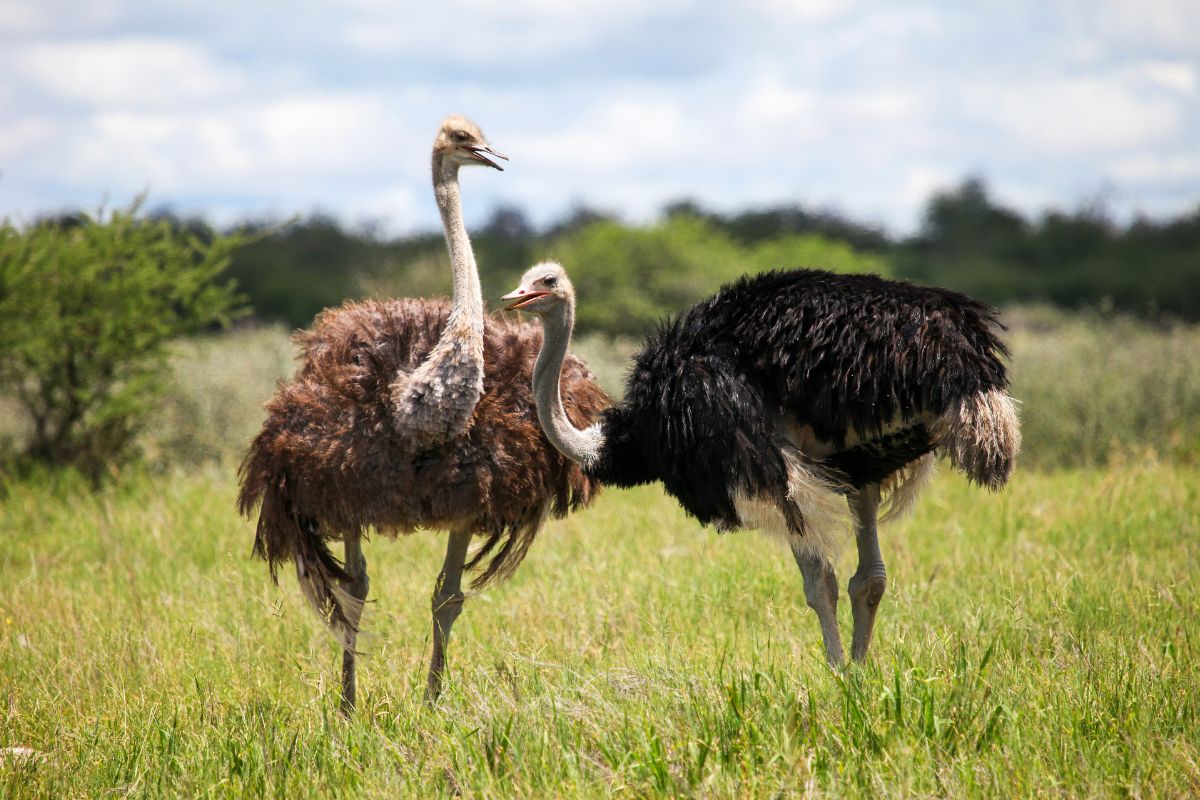Ostriches or Struthio camelus have big round eyes, long eyelashes, a shuddering walk, a tolerance to heat, and going without water, just like their namesake, the camel.

Once hunted to near extinction, the ostrich’s population was steeled by the advent of farming them for livestock. Today, ostriches live in the wild, primarily in sub-Saharan Africa. There is also a small population of them in the wild in Australia, where ostrich farming was unsuccessful.
What do ostriches eat? How different is a wild ostrich’s diet from a captive ostrich’s? Do ostriches really eat rocks? Keep reading for facts about the ostriches’ diet and how they eat.
Contents
Big Birds With a Big Appetite
Ostriches are the largest bird on Earth. They can grow up to 9’ tall and weigh as much as 350 pounds. They have round bodies, tall necks, and long, powerful legs. Because of their size, ostriches are flightless.
While ostriches can’t fly, they do know how to move and can reach sprinting speeds of over 40 miles per hour. They have strong muscular legs, and the fact that they have only two toes rather than the three or four of other birds means they can run faster. Ostriches can usually outrun any predator.
If an ostrich cannot outrun its predator or is surprised or cornered, it can use its legs and the sharp claws on its toes to unleash a massive kick that can cause severe damage and has even been known to kill lions and other large predators.
Ostriches burying their head in the ground to avoid danger is a myth, but they can lie down to hide from a hunting animal.
Ostriches are big, strong, fast, and require a lot of food and nutrition for survival, eating between three and four pounds of food a day.
Wild Ostrich Diet

Most wild ostriches live in sub-Saharan Africa. Like any animal, the ostriches’ habitat and environment determine its diet, and ostriches are really good at finding and getting the nutrition they need from what they have available. Ostriches are omnivorous, meaning they eat anything from fruits and plants to insects, small animals, and even stones.
Even though technically omnivorous, some people consider the ostrich to be an herbivore as their diet tends to be plant-heavy. Generally, a wild ostrich diet breakdown is 60% plants and plant matter, 20% grains, salts, or stones, 15% fruits and legumes, and 5% insects and small animals.
Ostriches graze, often eating alongside giraffes, zebras, and antelopes, as they can often alert other animals to approaching danger. They are selective but also opportunistic feeders.
They will drink water when they have the chance but can survive a long time without it. Some of the things ostriches in the wild eat include:
- Nuts
- Succulents
- Sprouts
- Berries
- Plant roots
- Plant seeds
- Green grasses
- Wild leaves and bushes
- Shrubs
- Mice
- Moths
- Crickets
- Rats
- Small turtles
- Snakes
- Lizards
- Frogs
- Grasshoppers
- Locusts
- Carrion left by large predators
Captive and Farmed Ostrich Diet
Ostriches do well in captivity, living the fifty years they tend to in the wild, and some live longer, even up to 70 years, if kept and fed well.
The goal of a diet for ostriches that live in captivity, whether in a zoo or as livestock, is to replicate the nutritional needs met by the wild ostrich diet as much as possible so the birds can grow healthily and thrive.
Typically, captive ostriches are fed a combination of fruit, vegetable, and commercial ostrich food. Because ostrich farming does not have as long a history as other types of livestock farming, like sheep or cattle, there is somewhat of a lack of information and standardization when it comes to commercial ostrich feed.
The best commercial ostrich feed companies research to ensure they have the correct amounts and types of vitamins and minerals in their feed, suitable for the different stages of an ostrich’s life.
Captive ostriches particularly like to snack on broccoli, cabbage, beets, carrots, and oranges. These delicious treats need to be chopped up well before serving; however, since ostriches don’t have teeth, they will swallow them whole and could choke.
Ostrich Chick Diet

Baby ostriches, or chicks, absorb the rest of the yolk sac from their egg into their abdomens, giving them enough nourishment and nutrients to survive for around 14 days. They usually start eating after approximately seven days, so they maintain growth as the nutrients from the yolk sac begin to deplete.
Ostrich chicks learn how to eat and feed by watching their parents. For ostrich chicks in captivity, it is critical they are given a chance to feed with older birds so they can learn how from them.
How Ostriches Eat and Digest Their Food
Ostriches don’t eat stones out of ignorance or greed. It is all about how they digest the rest of the food they eat. Rocks that ostriches eat have a particular purpose, and for that, they are given a special name, gastroliths.
Because ostriches don’t have teeth, they swallow the food they eat whole. To break down the food so it can be absorbed, ostriches have an organ called a gizzard. The stones and other hard, rough matter stay in their gizzard, where they physically break down the food.
Ostriches can have up to three pounds of rocks in their gizzard at a time. When the gastroliths have become smooth from use, they are regurgitated and replaced.
When an ostrich feeds, the food is broken down by its gizzard, then goes to its proventriculus. The proventriculus is similar to the human stomach as it breaks down food using chemicals. The ostrich’s food goes back and forth between the gizzard and the proventriculus until it is broken down enough to be absorbed in the intestine. An ostrich’s digestive process can take 36 hours.
Ostrich Facts
With their size, speed, strength, variety of their diet, and unique digestive system, ostriches are full of surprises. Here are some other interesting and unexpected facts about ostriches:
Only Two Species

There are only two species of ostrich. The Common ostrich can be found south of the Sahara and in eastern and southern Africa. The Somali ostrich lives in Somalia, Ethiopia, Djibouti, and Kenya. The ostriches that live in Australia are non-native birds that survived release from farms to form a free-range population.
While emus may look similar to an ostrich, it’s easy to tell them apart. Emus are smaller than ostriches and have three toes on their feet instead of two.
Communal Nests
Ostrich nests are communal. Several birds lay their eggs in the same nest, and then one female incubates them during the day, with a male taking over during the night.
A nest can fit and may have 30-40 eggs, but an ostrich can only cover about 20 of them with its body, so they eject the rest.
One of the reasons ostriches need so much nutrition is for breeding and hatching. On average, an ostrich egg weighs three pounds, about the same as two dozen chicken eggs.
Living in Herds
Ostriches live in groups called herds. A herd of ostriches is about twelve birds. Males compete for control, and the winner becomes the herd’s leader. Each herd also has a dominant female, or hen, who will only mate with the leader. The leader, however, may choose to mate with other hens in the herd.
Built for Survival
Like a camel’s, the ostriches’ long eyelashes protect it from sandstorms and duststorms that are common and could cause lasting damage to the bird’s vision.
Ostriches can also survive without water for a long time because they get most of the water they need from their food. However, they also have the ability to raise their body temperature and limit water loss. Also, unlike other birds, ostriches eliminate their urine and feces separately, leading to less water loss.
Wings as Rudders
Even though they don’t use them to fly, ostriches have a wingspan of over 6 feet. They use their outstretched wings to help them balance when running and can also use them to help shift direction while fleeing. Male ostriches also use their wings to dance as part of a mating display.
Final Thoughts

Ostritches are selective eaters. They prefer plant matter, but they will eat practically anything, including small animals, insects, and carrion. Because of their size, they need a lot of food, nutrients, and minerals, and their varied diet shows they know how to get it.
While people usually remark on their speed, their ability to hide, or to knock down a large predator with a kick, the ostrich’s diet, more than anything, proves it is a bird that excels at survival.
